When is the best time to visit Cairns? It’s not an easy question to answer as it’s influenced greatly by:
- Your interests (for example, you may want to visit Cairns during whale season);
- Your travel budget;
- When you can take holidays;
- The tourist seasons; and
- What you consider to be ideal weather.
Events such as Australian School Holiday periods can also greatly impact on when is a good time to travel to Cairns.
Personally, we think May (just watch out for stingers) and later in October are some of the best months to visit Cairns as the weather conditions are generally excellent. These months also avoid school holiday periods and the peak tourist period in June to August which means you’ll have more options for accommodation, attractions and experiences. However, these months may not match up with when you and your family or friends can travel.
If you can’t travel during these shoulder periods you’ll be faced with the choice of:
- Travelling to Cairns when the weather is close to perfect but it will be busier and prices will be higher; or
- Travelling when the weather is a little more extreme but you’ll have greater flexibility with where to stay and things to do and you’ll get cheaper prices.
In this article, we’re going to equip you with heaps of information about the seasons, weather and popular travel periods to help you make a decision about the best time to travel to Cairns that is right for you.
Join the Great Barrier Reef Travel Planning Facebook Group
Check out our Great Barrier Reef Travel Planning Facebook Group – you are welcome to join and it is a great resource to enable you to ask questions about your Great Barrier Reef trip, including gateway towns and what to do on land!
Disclaimer: This article contains affiliate links. If you book after clicking on one of these links then we may receive a small commission at no extra cost to you.
1. Seasons and Weather
An understanding of Australian seasons and weather is really important when working out the best time to go to Cairns. Australia is a southern hemisphere country so the seasons are opposite to the northern hemisphere:
- Summer – December to February
- Autumn – March to May
- Winter – June to August
- Spring – September to November
Temperatures are consistently pleasant in Cairns with average maximum temperatures ranging from 26°C (79°F) to 32°C (90°F). It never gets insanely hot (unlike some parts of Australia) nor does it ever get particularly cold. This narrow temperature range means that anytime is a great time to visit Cairns. Because Cairns is in the Australian tropics, humidity is consistently quite high, ranging from 64% average humidity in October to an average of 78% humidity in February.
The main weather factor to take into account when planning is rainfall. Because Cairns is in the Australian tropics, there are two distinct rainfall seasons: the Wet Season (from December to April) and the Dry Season (May to November) as you can see from the table below.
The Wet Season (December to April) is also Cyclone Season, when Cairns is most at risk of experiencing a cyclone. Hurricanes and typhoons are the same weather phenomenon as cyclones. The periods of highest humidity also match quite closely to the Wet Season as Cairns is most humid from January to May.
Marine stinger season also overlaps with the wet season as it typically runs from November through to May. While marine stingers may be present throughout the year in tropical Queensland, the risk associated with the two main potentially dangerous jellyfish are higher in the Cairns Stinger Season.
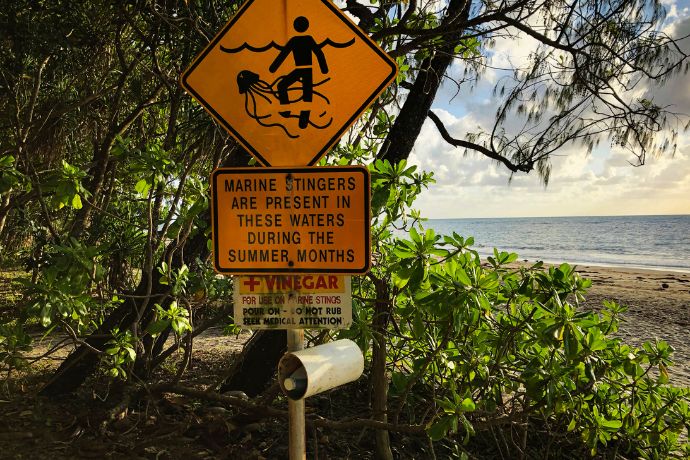
We’ve included detailed weather data at the end of each of the season sections which was sourced from the Australian Bureau of Meteorology (based on 1991-2020 data). Average sea temperature information came from Sea Temperature.
You’ll notice that while the temperatures are relatively consistent all year round, the varying levels of rainfall means that there are distinct advantages and disadvantages for each of the seasons. Your personal preferences and interests will largely determine the best month to visit Cairns.
Summer
Summer in Cairns is when most of the rainfall occurs but with rain mostly falling in the late afternoon and overnight, you’ll get to enjoy heaps of activities with some planning. Summer is also when the average temperatures are highest. The humidity is also at its highest in January and February. Here are some of the pros and cons to travelling to Cairns in Summer.
Advantages
- Vegetation is vibrant and lush so it’s a great time to check out the rainforests around Cairns as they will look magnificent.
- Rivers and waterfalls are at their most dramatic as water is flowing freely. You can get to experience the thundering power of Barron Falls (Din Din) and other waterfalls in the area.
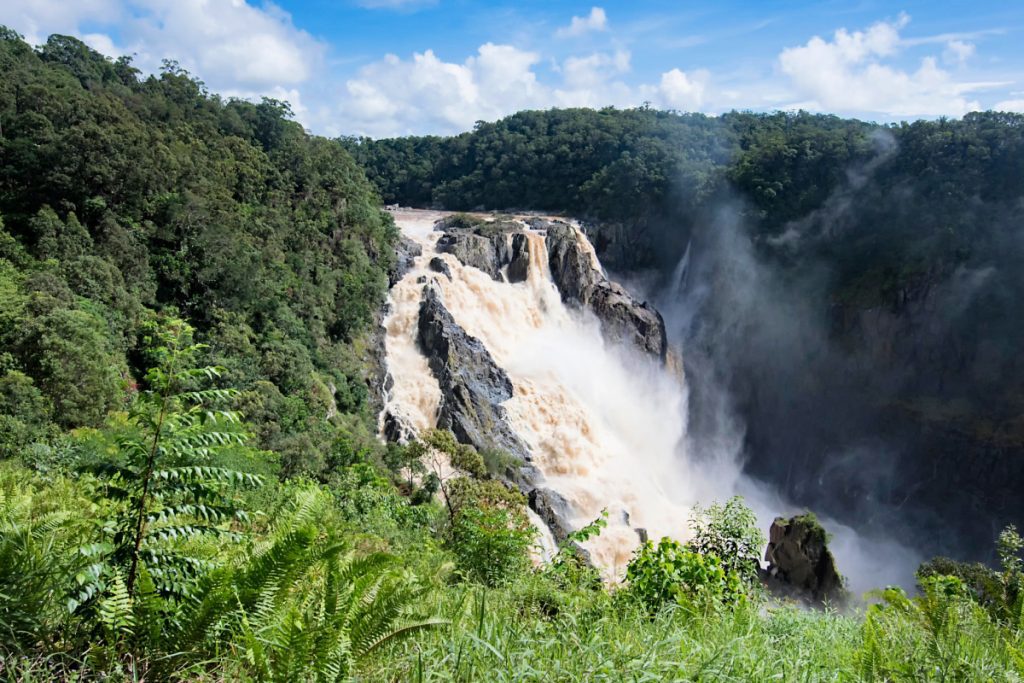
- The water temperature is warm.
- Coral spawning varies from year to year but normally takes place in November-December.
- Not as many fellow tourists visit except for around Christmas. You’ll likely find the best deals for experiences such as snorkelling and diving in this period.
Disadvantages
- Stinger season. Most popular beaches have stinger nets, lots of people wear stinger sets, and local authorities provide warnings so the risk is generally quite low. The jellyfish are generally in shallower waters so you won’t normally come across them when diving or snorkelling on the Great Barrier Reef.
- There are more rainy days and a higher volume of rain. The rain generally occurs in the afternoon and evening so have some rain gear, pay attention to the weather and prepare to be flexible if you are planning outdoor activities.
- Higher risk of heavy rain and cyclones. In the event of cyclones you’ll need to stay inside and the risk of flash flooding could cause issues such as road closures.
- The school holiday period around Christmas will be busier.
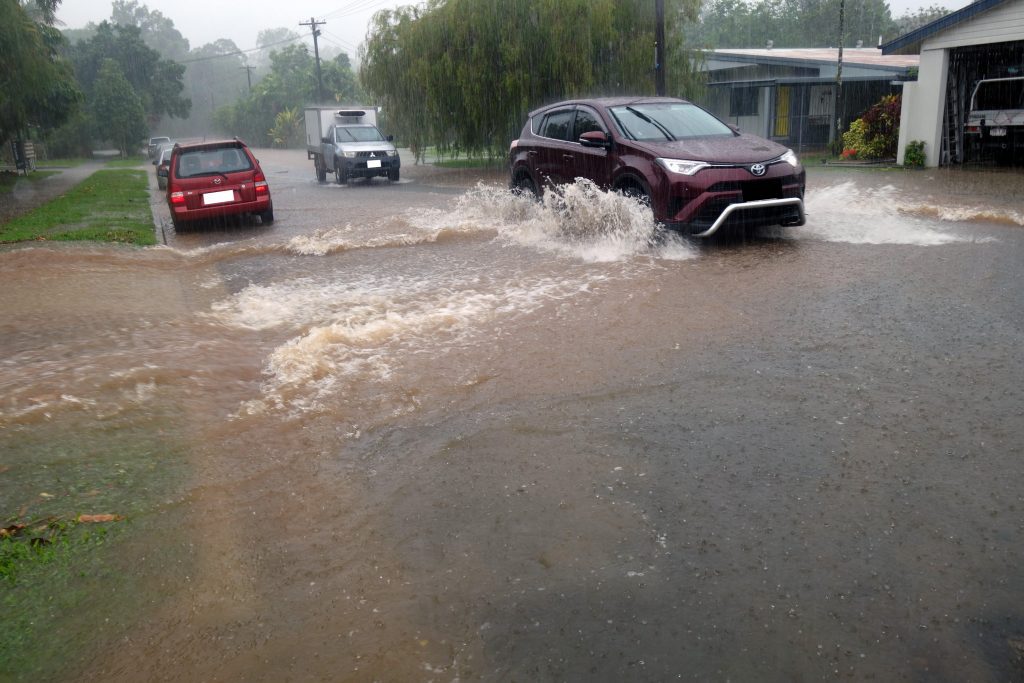
Monthly Averages | Max Temp °C/°F | Min Temp °C/°F | Water Temp °C/°F | Humidity (at 9 am) | Rainfall mm/inches | No. of Days of Rainfall |
December | 31.8°C / 89.2°F | 23.7°C / 74.7°F | 28.8°C / 83.8°F | 70% | 190 mm / 7.5 in | 11 |
January | 31.7°C / 89.1°F | 24.0°C / 75.2°F | 29.5°C / 85.1°F | 75% | 389 mm / 15.3 in | 16 |
February | 31.5°C / 88.7°F | 24.1°C / 75.4°F | 29.2°C / 84.6°F | 78% | 479 mm / 18.9 in | 15 |
Autumn (March to May)
Autumn is definitely one of the best times to visit Cairns from a weather perspective. In March rainfall is still high but it starts to drop off in April and there is significantly less rain in May. Average maximum temperatures also start to reduce from March to May. Humidity is consistently high through Autumn. Earlier in Autumn is an ideal time to visit rainforests as well as places such as Kuranda and to ride the Skyrail or the Scenic Railway.
Advantages
- Vegetation is still vibrant due to the higher rainfall (particularly in early Autumn).
- Rivers and waterfalls are still flowing strongly but will start to taper later in Autumn.
- Water temperature is still very pleasant so it’s a great time to swim in both the ocean and freshwater swimming holes.
- Autumn is right up there in terms of the best time to visit the Great Barrier Reef for activities like snorkelling and scuba diving. It’s also a great time for other water-based activities such as white-water rafting.
- You can get some great deals for accommodation, tours and activities.
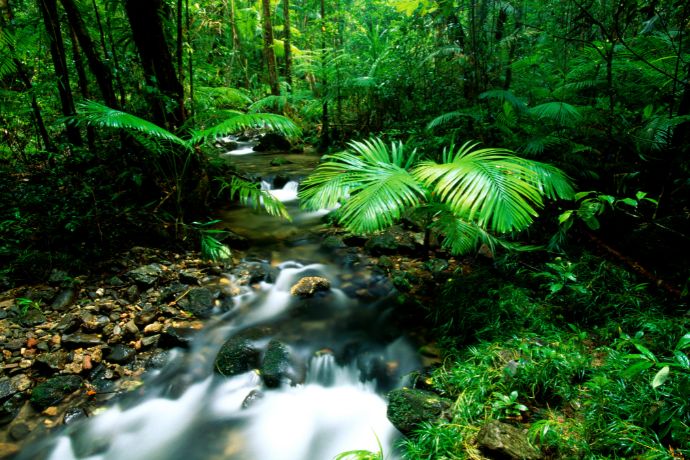
Monthly Averages | Max Temp °C/°F | Min Temp °C/°F | Water Temp °C/°F | Humidity (at 9 am) | Rainfall mm/inches | No. of Days of Rainfall |
March | 30.9°C / 87.6°F | 23.4°C / 74.1°F | 28.5°C / 83.3°F | 75% | 368 mm / 14.5 in | 15 |
April | 29.6°C / 85.3°F | 22°C / 71.6°F | 27.6°C / 81.7°F | 76% | 176 mm / 6.9 in | 14 |
May | 28.0°C / 82.4°F | 20.1°C / 68.2°F | 26°C / 78.8°F | 74% | 81 mm / 3.2 in | 10 |
Disadvantages
- There will be more tourists in April due to the Autumn School Holiday periods in the various Australian states.
Winter (June to August)
Weather conditions in Cairns are just about perfect in Winter. Technically June to August is Winter but you could hardly call average maximum temperatures hovering around 27°C (81°F) and minimums around 17°C (63°F) winter-like conditions. Over Winter, the humidity levels drop to around 70% and rainfall is low.
Mild to warm daytime temperatures and heaps of sunshine make Winter a great time to visit Cairns and it aligns perfectly with some of the coldest and harshest winter weather in Australian states such as Victoria and New South Wales. This means people from the southern Australian states head to Cairns for the warmth, sunshine and fun particularly during Australian School Holidays.
These months are also busy periods for international visitors due to Summer holidays in the Northern Hemisphere.
Advantages
- The temperature should be just about perfect, neither too hot nor too cold.
- The drier weather is ideal for activities such as hot air ballooning that are at their most reliable without the risk of rainy skies.
- Whale watching season is in full swing during Winter as the whales head north in search of cooler water. Dwarf Minke whales are in the area until around the end of July. Peak Humpback whale season is in July-August but can extend into September depending on water temperatures.
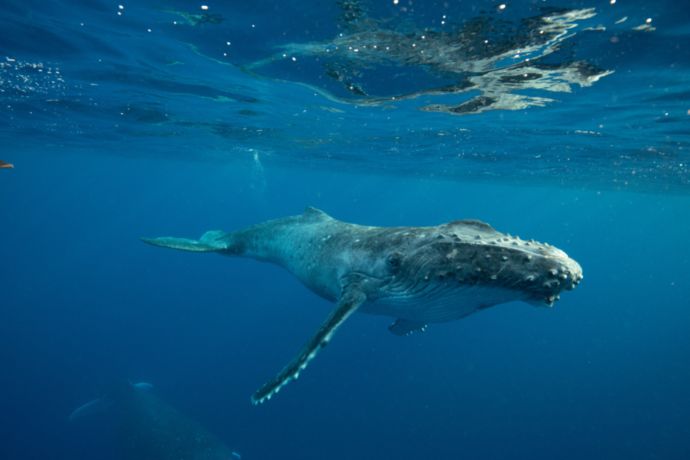
Disadvantages
- This is peak season for travel to Cairns so you’re more likely to encounter crowds and pay more for Cairns accommodation – particularly after the Winter School Holidays in late June. Accommodation and tours could fill up more quickly so book in early. Repeat visitors to the area sometimes book accommodation almost a year in advance.
- Most people will feel more comfortable wearing a wetsuit when swimming, snorkelling or diving. Most tour companies will provide wetsuits and you can also hire wetsuits.
- You might want to pack some warmer layers, particularly for the evenings.
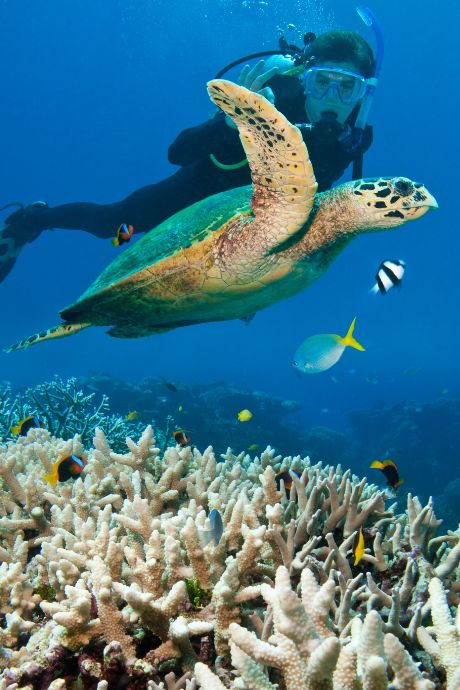
Monthly Averages | Max Temp °C/°F | Min Temp °C/°F | Water Temp °C/°F | Humidity (at 9 am) | Rainfall mm/inches | No. of Days of Rainfall |
June | 26.6°C / 79.9°F | 18.5°C / 65.3°F | 24.6°C / 76.3°F | 72% | 43 mm / 1.7 in | 7 |
July | 26.2°C / 79.2°F | 17.2°C / 63.0°F | 23.7°C / 74.7°F | 70% | 36 mm / 1.4 in | 6 |
August | 27.0°C / 80.6°F | 17.3°C / 63.1°F | 23.9°C / 75.0°F | 68% | 27 mm / 1.1 in | 5 |
Spring (September to November)
In Spring the weather is still close to perfect with moderate temperatures and limited rainfall. You’ll notice the temperature and humidity start to pick up particularly in November as Cairns starts to head back into the Wet Season.
Advantages
- Spring is perfect beach weather and you won’t to have to start thinking about Stinger Season until November.
- Plants start to flower and there’s heaps of animal activity so it’s a great time for lovers of flora and fauna.
- Water temperatures jump up in October.
- Coral starts to spawn in November.
- Some great accommodation deals are available as it’s no longer the peak travel season however the Spring school holidays will be busier (late September to early October).

Disadvantages
- There will be more tourists around in late September and early October due to Australian School Holiday periods.
Monthly Averages | Max Temp °C/°F | Min Temp °C/°F | Water Temp °C/°F | Humidity (at 9 am) | Rainfall mm/inches | No. of Days of Rainfall |
September | 28.7°C / 83.7°F | 18.8°C / 65.9°F | 24.9°C / 76.8°F | 65% | 29 mm / 1.1 in | 4 |
October | 29.9°C / 85.8°F | 20.8°C / 69.4°F | 26.4°C / 79.7°F | 64% | 63 mm / 2.5 in | 6 |
November | 31.1°C / 88.0°F | 22.5°C / 72.5°F | 27.4°C / 81.3°F | 67% | 85 mm / 3.3 in | 8 |
2. Australian and Cairns Travel Seasons
In the travel industry there are three main travel seasons: peak season, shoulder season, and off-season. In Cairns, the travel seasons are roughly as follows:
- Peak Season – June to August
- Shoulder Season – April/May and September/October
- Off-Season – November to March.
However, Cairns doesn’t really have a clearly distinct travel off-season unlike many travel destinations. There are plenty of people that still visit Cairns in the November to March period, it’s just relatively less popular than in the July to August period.
Australian School Holiday periods
Apart from the weather, the main factor that impacts on the travel seasons in Cairns are the Australian School Holiday periods and, less importantly, public holidays. When school holidays across the different Australian states start the number of tourists to Cairns increases, accommodation availability goes down and prices increase. When children go back to school, tourist numbers go down, choices increase and prices go down. It’s all about supply and demand.
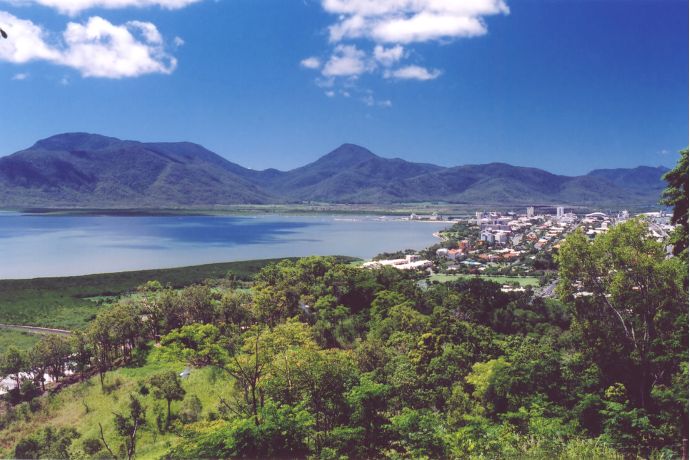
Australian school holidays work quite differently to many other countries. Children generally attend school for about 10 to 11 weeks (called a term) and then they have a school holiday period. In the Autumn, Winter and Spring holidays children have about a two week break from school. Summer holidays are normally about six weeks in length.
School Holiday periods and Public Holidays differ between the various Australian States and Territories. Check out when the 2022 and 2023 school holidays are occurring as the 2022 Public Holidays and the 2023 Public Holidays. We’ve also summarised the 2023 school holiday dates in the table below. The table includes clinks to the official Education Department school holiday pages for each Australian State and Territory.
States/Territories | Autumn 2023 | Winter 2023 | Spring 2023 | Summer 2023 |
1 April to 16 April | 24 June to 9 July | 16 September to 2 October | 9 December to 21 January 2024 | |
7 April to 23 April | 1 July to 16 July | 23 September to 8 October | 20 December to 29 January 2024 | |
7 April to 23 April | 1 July to 16 July | 23 September to 8 October | 16 December to 28 January 2024 | |
7 April to 23 April | 24 June to 9 July | 16 September to 1 October | 21 December to 28 January 2024 | |
6 April to 25 April | 8 July to 24 July | 30 September to 15 October | 22 December | |
15 April to 30 April | 8 July to 23 July | 30 September to 15 October | 16 December to 28 January 2024 | |
7 April to 23 April | 1 July to 16 July | 23 September to 8 October | 15 December to 30 January 2024 | |
7 April to 16 April | 24 June to 17 July | 23 September to 8 October | 16 December to 29 January 2024 |
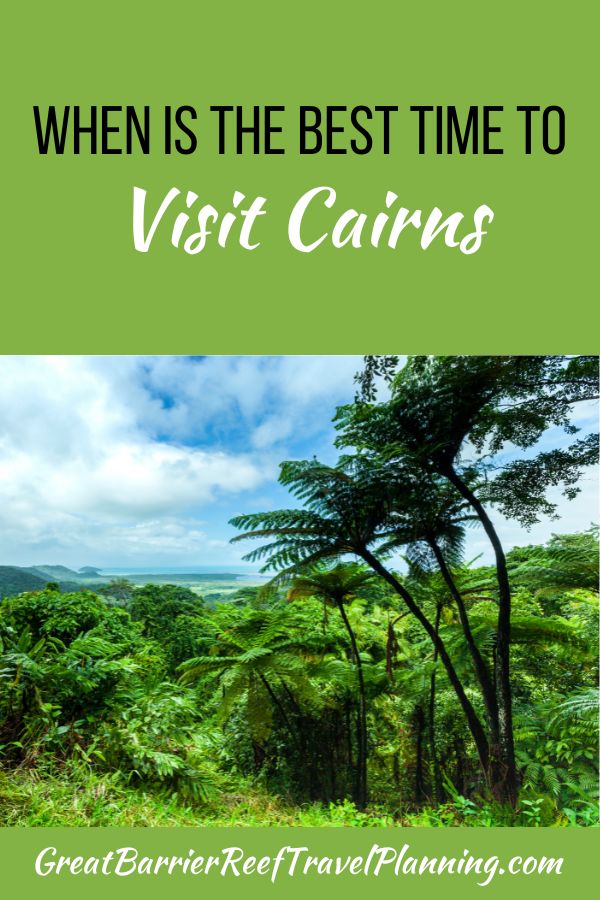
Join the Great Barrier Reef Travel Planning Facebook Group
Check out our Great Barrier Reef Travel Planning Facebook Group – you are welcome to join and it is a great resource to enable you to ask questions about your Great Barrier Reef trip, including gateway towns and what to do on land!
Disclaimer: This article contains affiliate links. If you book after clicking on one of these links then we may receive a small commission at no extra cost to you.


